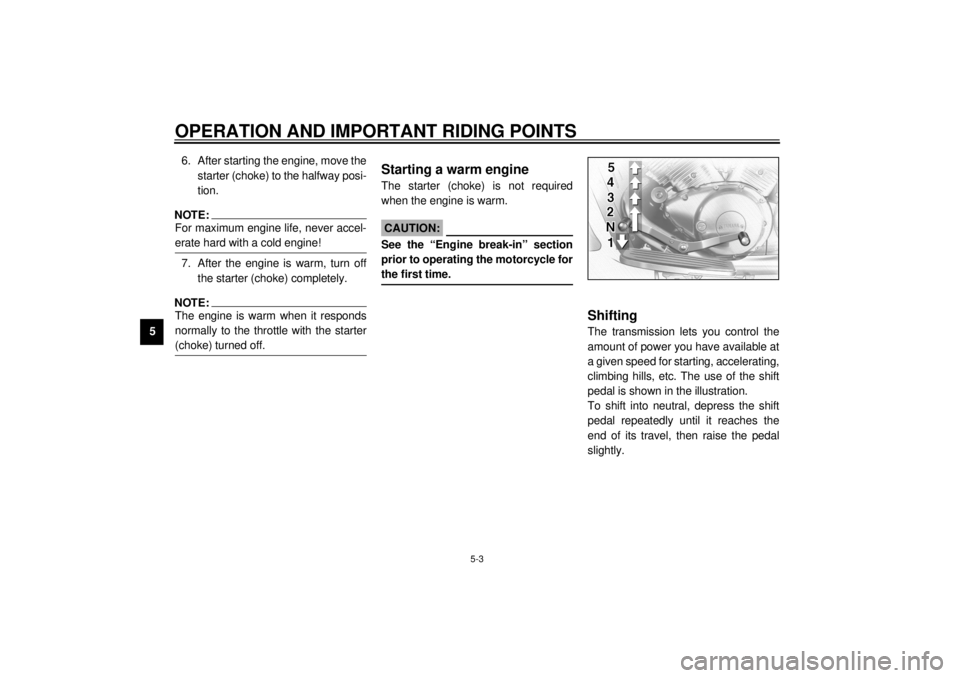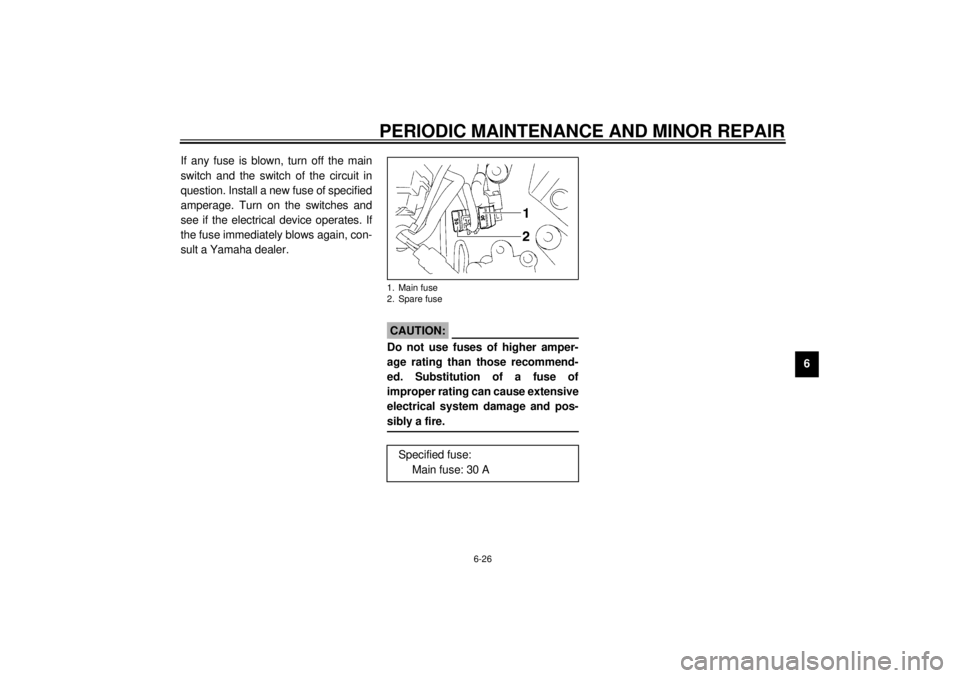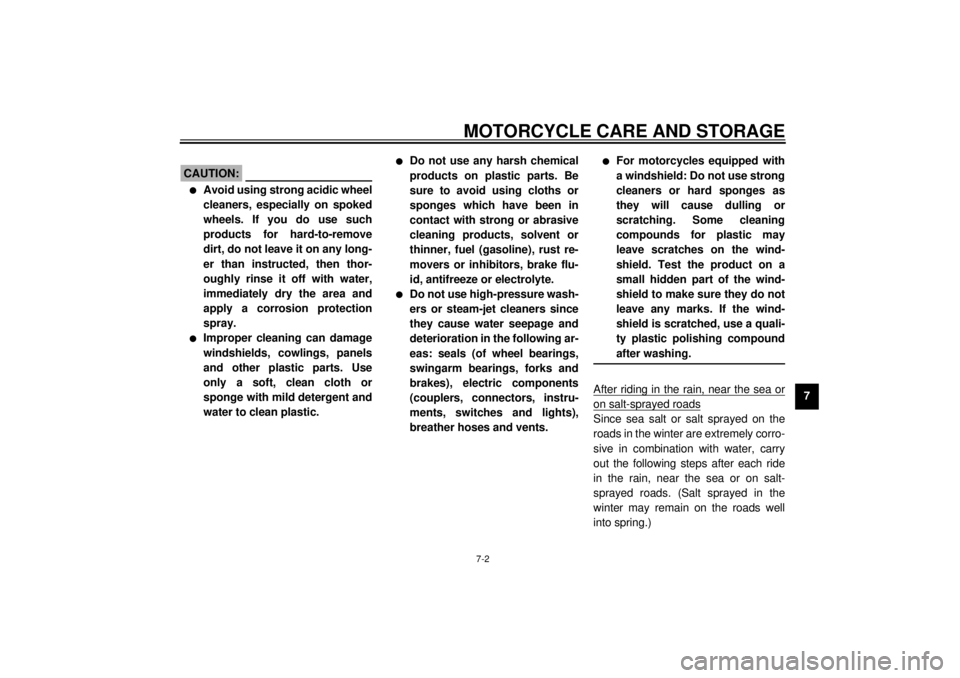2000 YAMAHA XVZ1300A ESP
[x] Cancel search: ESPPage 28 of 91

INSTRUMENT AND CONTROL FUNCTIONS
3-14
3
EC000015
CAUTION:@ Never attempt to turn an adjuster
beyond the maximum or minimum
setting. @3. Tighten the locknut to the speci-
fied torque.
EC000018
CAUTION:@ Always tighten the locknut against
the spring adjusting nut and tighten
the locknut to the specified torque. @
EAU00315
WARNING
@ This shock absorber contains high-
ly pressurized nitrogen gas. Read
and understand the following infor-
mation before handling the shock
absorber. The manufacturer cannot
be held responsible for property
damage or personal injury that may
result from improper handling.l
Do not tamper with or attempt to
open the cylinder assembly.
l
Do not subject the shock ab-
sorber to an open flame or other
high heat source. This may
cause the unit to explode due to
excessive gas pressure.
l
Do not deform or damage the
cylinder in any way. Cylinder
damage will result in poor
damping performance.
l
Take your shock absorber to a
Yamaha dealer for any service.
@
Spring preload:
Minimum (soft):
Distance “A” = 48.5 mm
Standard:
Distance “A” = 45.5 mm
Maximum (hard):
Distance “A” = 40.5 mm
Tightening torque:
Locknut:
25 Nm (2.5 m·kg)
E_4YP_Functions.fm Page 14 Wednesday, October 6, 1999 10:03 AM
Page 31 of 91

4-1
4
EAU01114
4-PRE-OPERATION CHECKSOwners are personally responsible for their vehicle’s condition. Your motorcycle’s vital functions can start to deteriorate
quickly and unexpectedly, even if it remains unused (for instance, if it is exposed to the elements). Any damage, fluid leak or
loss of tire pressure could have serious consequences. Therefore, it is very important that, in addition to a thorough visual in-
spection, you check the following points before each ride.
EAU00340
PRE-OPERATION CHECK LIST
ITEM CHECKS PAGE
Front brake• Check operation, fluid level and vehicle for fluid leakage.
• Fill with DOT 4 brake fluid if necessary.
6-17 ~ 6-21
Rear brake• Check operation, fluid level and vehicle for fluid leakage.
• Fill with DOT 4 brake fluid if necessary.
Clutch• Check operation, fluid level and vehicle for fluid leakage.
• Fill with DOT 4 brake fluid if necessary.6-16
Throttle grip and housing• Check for smooth operation.
• Lubricate if necessary.6-12
Engine oil• Check oil level.
• Fill with oil if necessary.6-7 ~ 6-9
Coolant reservoir tank• Check coolant level.
• Fill with coolant if necessary.6-10 ~ 6-11
Final gear oil• Check vehicle for leakage. 6-10
Wheels and tires• Check tire pressure, wear and for damage. 6-13 ~ 6-16
Brake and shift pedal
shafts• Check for smooth operation.
• Lubricate if necessary.6-21
Brake and clutch lever
pivots• Check for smooth operation.
• Lubricate if necessary.6-22
Sidestand pivot• Check for smooth operation.
• Lubricate if necessary.6-22
E_4YP_Preop.fm Page 1 Wednesday, October 6, 1999 10:04 AM
Page 37 of 91

OPERATION AND IMPORTANT RIDING POINTS
5-3
56. After starting the engine, move the
starter (choke) to the halfway posi-
tion.
NOTE:@ For maximum engine life, never accel-
erate hard with a cold engine! @7. After the engine is warm, turn off
the starter (choke) completely.NOTE:@ The engine is warm when it responds
normally to the throttle with the starter
(choke) turned off. @
EAU01258
Starting a warm engineThe starter (choke) is not required
when the engine is warm.
EC000046
CAUTION:@ See the “Engine break-in” section
prior to operating the motorcycle for
the first time. @
EAU00423
ShiftingThe transmission lets you control the
amount of power you have available at
a given speed for starting, accelerating,
climbing hills, etc. The use of the shift
pedal is shown in the illustration.
To shift into neutral, depress the shift
pedal repeatedly until it reaches the
end of its travel, then raise the pedal
slightly.
E_4YP_Operation.fm Page 3 Wednesday, October 6, 1999 10:05 AM
Page 53 of 91

PERIODIC MAINTENANCE AND MINOR REPAIR
6-11
6
NOTE:@ l
If water is added, have a Yamaha
dealer check the antifreeze con-
tent of the coolant as soon as pos-
sible.
l
Have a Yamaha dealer change
the coolant every two years.
l
The radiator fan operation is com-
pletely automatic. It is switched on
or off according to the coolant tem-
perature in the radiator.
@
EAU00630
Carburetor adjustmentThe carburetors are important parts of
the engine and require very sophisti-
cated adjustment. Most adjustments
should be left to a Yamaha dealer who
has the professional knowledge and
experience to do so. However, the idle
speed may be adjusted by the owner
as part of routine maintenance.
EC000095
CAUTION:@ The carburetors were set at the
Yamaha factory after many tests. If
they are changed, poor engine per-
formance and damage may result. @
EAU01168
Idle speed adjustmentNOTE:@ A diagnostic tachometer must be used
for this procedure. @1. Attach the tachometer. Start the
engine and warm it up for a few
minutes at approximately 1,000 to
2,000 r/min. Occasionally rev the
engine to 4,000 to 5,000 r/min.
The engine is warm when it quick-
ly responds to the throttle.
1. Reservoir tank capE_4YP_Periodic.fm Page 11 Wednesday, October 6, 1999 10:05 AM
Page 68 of 91

PERIODIC MAINTENANCE AND MINOR REPAIR
6-26
6 If any fuse is blown, turn off the main
switch and the switch of the circuit in
question. Install a new fuse of specified
amperage. Turn on the switches and
see if the electrical device operates. If
the fuse immediately blows again, con-
sult a Yamaha dealer.
EC000103
CAUTION:@ Do not use fuses of higher amper-
age rating than those recommend-
ed. Substitution of a fuse of
improper rating can cause extensive
electrical system damage and pos-
sibly a fire. @1. Main fuse
2. Spare fuseSpecified fuse:
Main fuse: 30 A
E_4YP_Periodic.fm Page 26 Wednesday, October 6, 1999 10:05 AM
Page 76 of 91

MOTORCYCLE CARE AND STORAGE
7-2
7
ECA00010
CAUTION:@ l
Avoid using strong acidic wheel
cleaners, especially on spoked
wheels. If you do use such
products for hard-to-remove
dirt, do not leave it on any long-
er than instructed, then thor-
oughly rinse it off with water,
immediately dry the area and
apply a corrosion protection
spray.
l
Improper cleaning can damage
windshields, cowlings, panels
and other plastic parts. Use
only a soft, clean cloth or
sponge with mild detergent and
water to clean plastic.
l
Do not use any harsh chemical
products on plastic parts. Be
sure to avoid using cloths or
sponges which have been in
contact with strong or abrasive
cleaning products, solvent or
thinner, fuel (gasoline), rust re-
movers or inhibitors, brake flu-
id, antifreeze or electrolyte.
l
Do not use high-pressure wash-
ers or steam-jet cleaners since
they cause water seepage and
deterioration in the following ar-
eas: seals (of wheel bearings,
swingarm bearings, forks and
brakes), electric components
(couplers, connectors, instru-
ments, switches and lights),
breather hoses and vents.
l
For motorcycles equipped with
a windshield: Do not use strong
cleaners or hard sponges as
they will cause dulling or
scratching. Some cleaning
compounds for plastic may
leave scratches on the wind-
shield. Test the product on a
small hidden part of the wind-
shield to make sure they do not
leave any marks. If the wind-
shield is scratched, use a quali-
ty plastic polishing compound
after washing.
@After riding in the rain, near the sea oron salt-sprayed roadsSince sea salt or salt sprayed on the
roads in the winter are extremely corro-
sive in combination with water, carry
out the following steps after each ride
in the rain, near the sea or on salt-
sprayed roads. (Salt sprayed in the
winter may remain on the roads well
into spring.)
E_4YP_Cleaning.fm Page 2 Wednesday, October 6, 1999 10:06 AM